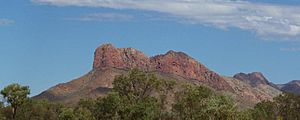Turkey Tolson Tjupurrula facts for kids
Quick facts for kids
Turkey Tolson Tjupurrula
|
|
|---|---|
| Born | circa 1942 Haasts Bluff, Northern Territory, Australia
|
| Died | 10 August 2001 (aged 58–59) Alice Springs, Northern Territory, Australia
|
| Other names | Tolson Tjupurrula, Tolsen, Turkey Tolson |
| Known for | Painting |
|
Works
|
Straightening spears at Ilyingaungau |
| Movement | Papunya Tula |
Turkey Tolson Tjupurrula (sometimes called Turkey Tolson) was an amazing Indigenous Australian artist. He was from the Pintupi people, who live in Australia's Western Desert. Born around 1938 near Haasts Bluff, Northern Territory, Turkey Tolson became a very important artist in the Papunya Tula art movement. He was also the longest-serving chairman of the company that helped these artists.
Turkey Tolson painted for almost 30 years! His most famous painting is Straightening spears at Ilyingaungau (1990). You can find his artworks in many big Australian art galleries, like the Art Gallery of South Australia and the National Gallery of Victoria.
His Life Story
Turkey Tolson Tjupurrula was born near Haasts Bluff, Northern Territory, which is west of Alice Springs. His father, Toba Tjakamarra, was one of the first Pintupi people to move from the Western Desert to European settlements. We're not exactly sure when Turkey Tolson was born, but it was around 1938 or 1943. His mother was one of Toba's three wives. His two stepmothers, Wintjiya Napaltjarri and Tjunkiya Napaltjarri, were also talented artists!
You might see 'Tjupurrula' in his name. This is a "skin name," which is a special name used by Indigenous people in central Australia. These names help show how people are related and what their roles are in the community. They are not like last names that Europeans use. So, 'Turkey Tolson' is the part of his name that is unique to him.
When he was young, Turkey Tolson worked in building and as a stockman (someone who looks after cattle) around Haasts Bluff. He was also very good at throwing spears! He only got to know his birth country well after he went through his initiation in 1959. He got married and moved with his family to Papunya, Northern Territory when it was being built. After his first wife passed away, he married Mary Napanungka in 1984. Then, he moved to Kintore, which was in his family's traditional lands. Later in his life, he had heart problems. He passed away on August 10, 2001, in Alice Springs.
His Art and Style
Modern Indigenous Australian art began in the western desert communities when Indigenous men in Papunya started painting in 1971. A teacher named Geoffrey Bardon helped them. Soon after, they created Papunya Tula, a company owned and run by the artists themselves. This company became Australia's most important Indigenous art center. Turkey Tolson was one of the first artists to paint with them, and he was also one of the youngest. He was very important in the Papunya Tula movement and was the chairman of the company for a long time. Besides painting, Turkey Tolson also made prints, and one of his prints is in the National Gallery of Australia.
Turkey Tolson's painting style changed over time.
- Early Style: His early paintings were very neat and controlled. They often had strong, balanced patterns of dots and geometric shapes. You can see this style in his works from the mid-1970s, like Dreaming at Kamparrarrpa (1976) and Two Women Mythology at Putja Rockhole (1977). These are held by the National Museum of Australia. He even worked with another artist, Johnny Scobie Tjapanangka, on some of these early pieces.
- Later Style: After his father passed away, Turkey Tolson took on more important ceremonial duties for his community. This change in his life also led to a change in his art. His later paintings had a looser style and more personal symbols. During this time, he created his most famous work, Straightening spears at Ilyingaungau (1990). This painting is at the Art Gallery of South Australia. Experts say it's his masterpiece! It shows shimmering horizontal lines that represent spears being heated and straightened over a fire by his ancestors. These paintings also tell stories about Dreamings (important spiritual stories) concerning fights between ancestral figures.
In 1999, there was some discussion about who painted some of his works. Turkey Tolson signed a paper saying that some paintings with his signature were actually painted by his female relatives. But then, he signed another paper that said the opposite. This situation made people think about what makes Aboriginal art authentic and how the art market can affect artists. It showed how important it was for artists to stay connected to the experiences that inspire their paintings.
Turkey Tolson's art has been shown in many important exhibitions. These include Papunya Tula: Out of the Australian desert at the National Museum of Australia in 2010. His painting Spear straightening ceremony (1993) was also part of an exhibition called Speaking in Colour in 2011.
Where to See His Art
You can find Turkey Tolson Tjupurrula's amazing artworks in these major collections:


